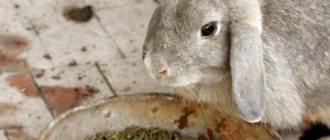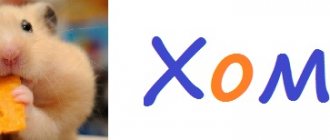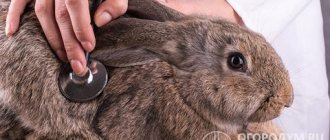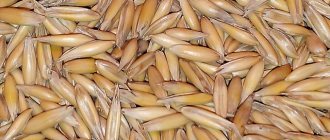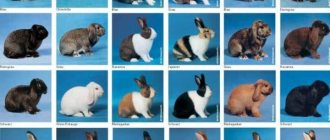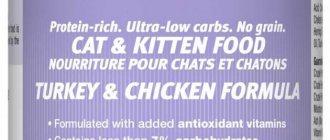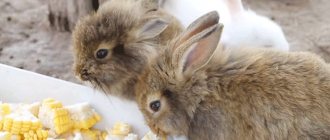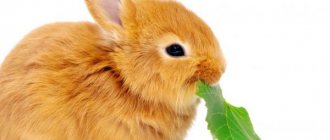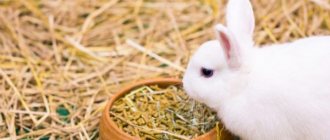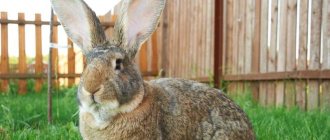Livestock » Rabbits
0
3129
Article rating
Kira Stoletova
Nowadays, one of the most popular pets, the breeding of which has recently been quite actively carried out, is the rabbit. In order for a rabbit to grow up healthy, it is necessary to take good care of it, including monitoring its daily nutrition. Anyone who is faced with raising this pet for the first time often wonders how much feed a rabbit eats per day. Let's consider how to feed this animal correctly and what the daily amount of food it should consume should be.
How much feed does a rabbit eat per day?
Types of feed
All rabbit food can be classified into one of three types:
- Roughage. These include grass, vegetable tops, cabbage, hay and tree branches. In winter, hay stored in the summer is fed as roughage. Roughage is the main supplier of fiber to animals.
- Juicy feed. These are root vegetables, silage, pumpkin, zucchini. As a rule, succulent feed ends up in the animal feeder during the winter. They serve as an essential source of vitamins, but are poor in fiber and protein. In lactating rabbits, large quantities of succulent feed increase the amount of milk.
- Concentrated feed. These include cereal grains and legumes, bran, cake, mixed feed, and animal feed. Concentrated feeds are rich in protein but poor in vitamins. With an increase in the dose of concentrated feed in the diet, the growth rate of animals increases.
Nutritional Features
Hay is a source of natural fiber. Consuming it helps digestion. Furry pets' teeth are constantly growing. In order for them to wear off in time, the animal must constantly chew.
If there are few chewing movements, this leads to the development of malocclusion.
An important aspect of nutrition is coprophagia - eating one's own excrement (cecotropes). Cecotropes are usually not noticed by owners, since the long-eared ones eat them directly from their anus.
Cecotropes consist of 28-30% crude protein. Contains nitrogen, short-chain fatty acids, microbial protein, B vitamins, sodium, potassium, water, lysine, sulfur amino acids and threonine. Cecotropes also help replenish the microflora of the cecum.
Coprophagia is a normal behavior of an animal that maintains an overall healthy state.
What is compound feed, its advantages and disadvantages
Compound feed is a crushed and mixed mixture of plant and animal feed. During the cooking process, vitamins, macro- and microelements are added to it. For better absorption by the animal’s body, all components are selected according to their chemical composition, complementing each other. For each type of animal, feed is produced according to its own recipe.
Advantages:
- reduces time spent on feeding animals;
- easy to transport, convenient to store;
- feeding with compound feed makes the animal’s diet balanced, preventing health problems;
- the feed contains many components, thereby providing variety in animal nutrition;
- The vitamin premixes included in the feed save animals from vitamin deficiency.
Flaws:
- excessive amounts of feed leads to obesity in animals;
- compound feed – soft food. If they replace the bulk of the food, the rabbits' incisors will not wear down. This will lead to problems with the gastrointestinal tract;
- the cost of purchased mixtures is quite high.
Fattening rabbits for weight gain
Plant and feed impurities are introduced into the food of rabbits from 2-3 months. The composition of feed at each age stage is different.
Without special fattening, the farm will not only remain without profit, but will not even recoup the costs of maintaining the long-eared animals.
The process of feeding rabbits involves three stages:
- preliminary (selection of a suitable diet);
- main (weight gain in pets);
- final (adjustment of weight and body fat).
The first period is characterized by increased nutrition of young animals.
In summer and winter, it is based on combined mixtures:
- wheat;
- leguminous plants;
- oats;
- corn.
The preparation stage is 5 days.
The main stage is aimed at the formation of the fat layer.
Animal nutrition includes foods containing fats:
- Boiled potatoes);
- flax seeds;
- cake
Porridge with milk is added to the rabbits' daily diet. The fattening period lasts 7-10 days.
The final stage involves maintaining the animals' appetite.
The liquid is salted, and seasonings from:
- dill;
- caraway;
- celery.
Constant monitoring is carried out to ensure that pets eat the required amount per day.
In the last days of feeding, hay and grass are excluded.
Amount of feed for fattening
Be sure to give the eared enough clean water.
In frosty weather, it is preferable to pour warm water into the drinking bowls. The use of exclusively mixed feed feeding is typical for industrial fur farms. For a mature individual, consumption per day is 100-110 g of feed, in which 55% is grains, corn, oats, 45% is cake and bran.
The nutrition of rabbits becomes complete due to the inclusion in the daily diet, in addition to compound feed, of auxiliary feeds, which are divided by type:
- green - a combined group of fresh plants (grass, tree leaves);
- juicy – represented by fruits and vegetables;
- coarse - hay.
Attention! The need for concentrated feed depends on the time of year, gender and age of the animal.
With mixed feeding, the dosage of feed per day is half as much (40-50 g), with the exception of:
- female puppies, who are prescribed 90 g in summer, 100 g in winter;
- nursing rabbits - 130 g in summer, 150 g - in winter.
Table 1. Annual feed requirement for combined fattening
| Type of individual | Stern | Quantity (kg) |
| Nursing female (24 rabbits) | Compound feed | 342 |
| Hay | 109 | |
| Silage, root crops | 90 | |
| Fresh grass | 420 |
Feeding cages for rabbits
The dimensions of the feeding cages are determined by:
- number of young animals;
- number of mature rodents;
- place where animals are kept.
General principles for organizing animal housing:
- Thoughtful location of the territory for maintenance (without drafts and strong winds).
- The choice of wood as a material for the frame and supports, for the walls - plywood or mesh.
- Keeping males separate from pregnant female rabbits and their joint offspring.
- Typical cage parameters for an adult are 1500x700x700 mm.
Table 2. Minimum sizes for keeping pets
| Classification | Standard area per head (sq. m) | Length(cm) | Width(cm) |
| For the main herd (two-section) | 1st section – 0.5-0.62nd section (nesting compartment) – 0.18 | 60-7050 | 9036 |
| For females (for 4 individuals) | 0,15 | 90 | 672 |
| For males (for one) | 0,605 | 90 | 672 |
| For young animals | 0,13-0,16 | 29-36 | 45 |
During the birthing period, the cubs are kept together with the female rabbit until they become stronger. For ease of cleaning, feeding boxes are made retractable or hanging.
The finished cells are placed at a distance of 20-50 cm from the floor. This will protect young rabbits from rodents.
Feed consumption rates
The norm depends on the age of the animal, physiological state and time of year. As a rule, there is usually a label on the packaging indicating how much of the product to give and to which animals.
According to the standards, for each animal it is necessary to allocate:
- adult rabbits – 180 grams;
- adult rabbits during the mating period - 230 grams;
- for female rabbits during pregnancy – 180 grams;
- nursing rabbits – 300 grams;
- young animals aged 1 month – 130 grams;
- at the age of 2 months – 150 grams;
- at the age of 3-4 months – 170 grams.
Compound feed is given to babies 5-6 times a day, to adult animals 2-3 times.
On a note! When feeding animal feed, animals must receive plenty of water.
A small lyrical digression.
Some of my friends would not mind having rabbits on their farm. They have a great desire to care for them, feed them, and, if necessary, take care of the health of their charges. But as soon as they think about their ultimate fate, their enthusiasm drops sharply. Potential rabbit breeders are frightened by the slaughter process itself, which is quite natural for the vast majority of normal people. It is especially difficult at the initial stage, when there are still few rabbits and you know almost all of them by name and nickname. In this case, there are two options. The first is to get a couple of decorative rabbits, the second is to use the services of slaughter stations or the help of experienced rabbit breeders you know.
In the future, as the economy grows, psychology undergoes some correction. The spirit of the hunter, the breadwinner of the family, is increasingly awakening in men, which also fits perfectly into human nature. By the way, not a single world religion prohibits killing animals for further consumption as food. The main thing is to observe morality and legality. Specifically, this is the complete absence of cruelty in actions, the quick and painless killing of an animal, not accompanied by a feeling of anxiety and fear. The animal must receive adequate care until the very moment of its killing. It should not be carried out in a room where animals are kept; it is prohibited to kill some animals in front of others, as well as in the presence of young children. If you wish, you can find more precise and complete wording in the laws of your countries.
Types of feed
The industry produces two types of combined feeds for rabbits:
- PC – fully rationed feed. Their composition fully satisfies all the needs of the animal body for nutrients, vitamins and microelements. When using this feed there is no need for additional feeding.
- Concentrated feeds are sold under the designation K or KK. This feed supplements the basic diet of animals with protein, fiber and minerals.
Different feed options are available for different ages of animals:
- for fattening young animals aged from one to five months, PK 90, PK 91, K91 are used;
- for feeding adult rabbits use K 92-1 and K 92-2;
- For final fattening of animals for meat, K93-1 compound feed is used.
Compound feed goes on sale in two states:
- granulated. An excellent option for complete feeding. Excellent storage, easy to dose, convenient for animals to eat;
- bulk mixtures. All components in them are ground into powder. It is most convenient to use them in mash.
On a note!
Feeding feed intended for other animals or birds can be harmful to rabbits due to the specific additives included in it.
Meat breeds of rabbits
Fattening rabbits for meat will become a profitable business only if the breed is chosen correctly.
New Zealand white rabbit
The meat type is characterized by the following characteristics:
- rapid growth and stable weight gain;
- high rate of pure product;
- excellent taste of meat.
Not all types of young rabbits are used for breeding and subsequent slaughter.
Meat breeds of rabbits suitable for fattening include:
- New Zealand white. By 5-6 months the animal’s weight is 5 kg. During the birth, 9-11 cubs appear. Rabbits can be kept in boxes with mesh flooring.
- New Zealand red. The female is larger than the male. Rabbits gain weight well. The yield of pure meat reaches almost 60%.
- Gray giant. Maximum weight – up to 6 kg. A female rabbit can give birth to up to 8 cubs. The breed is characterized by early maturity. The quality of the meat is good.
- Californian breed. It is distinguished by early ripening. During the year, one female gives birth to more than 30 cubs. The taste characteristics of meat and the density and density of wool are valued by consumers.
- Poltava silver. The breed is valued for its fluffy fur. Animal meat is pleasant and soft in taste.
- Ram (or lop-eared rabbit). Weight at the time of slaughter is about 8 kg. In one litter, the female brings 7-9 pieces. Rabbit meat tastes tender and light.
- Flanders Animals reach a length of 70 cm. Body weight is up to 10 kg. The meat is juicy and tasty. The breed is a late ripening breed; breeding requires a wide cage and constant care.
Rabbit breeders prefer the New Zealand white, gray giant and Californian breed.
What is feed made from?
Main components included:
- grain of wheat, barley, oats, corn;
- sunflower cake;
- legume grains: beans, peas, soybeans, lupine;
- oilseed grains: sunflower, rapeseed, rapeseed;
- roughage as a source of fiber;
- bran;
- bone flour;
- mineral, vitamin supplements, biostimulants.
In addition, to improve digestion, high-quality industrially produced feed includes:
You may be interested in: Industrial cages for rabbits at home: drawings How to make drinking bowls for rabbits with your own hands Cages for rabbits with your own hands: photos, original ideas
- acetic, ascorbic, benzoic and sorbic acids;
- ammonium hydroxide as a mold inhibitor;
- beet pulp – sugar production waste;
- source of calcium – limestone or calcium carbonate;
- source of protein – rapeseed flour, made from rapeseed after pressing the oil;
- B4 or choline chloride;
- preservative – citric acid. The use of citric acid helps to enhance growth and increase immunity in animals;
- flavoring additive – corn gluten;
- magnesium oxide;
- binding component and source of magnesium – black or cane molasses;
- source of phosphorus – monosodium phosphate;
- papaya to improve digestion;
- soybean hulls as a source of fiber;
- safflower flour as a source of protein;
- rosemary extract – a perfect natural antioxidant;
- safflower oil to improve taste;
- soybean meal is a source of protein;
- yucca to normalize the animal's gastrointestinal tract.
A few words about waste.
Slaughterhouse waste includes: paws, skins, technical offal during the slaughter process they are thrown into containers, and after completion of the slaughter they are sent for disposal.
That’s all we wanted to consider in this article, as you can see, the equipment as such comes down to an electric stunner and a high-quality cutting line, and most operations are performed manually, productivity in this case is determined by the number of personnel.
But for more productive enterprises, much more serious equipment will be required; we will continue to consider products and equipment for rabbit breeding in subsequent publications.
Self-production of feed
A prerequisite for this is the presence of a grain crusher. For complete mixing, all components must be ground to a homogeneous mass. To mix small volumes, you can use an electric drill with an attachment; for continuous feed production, it is easier to purchase a concrete mixer.
Full ration food recipe
- In a grain crusher, grain is ground into flour. 20% barley, 10% wheat, 10% corn, 5.5% soybeans are poured into the container.
- Add 40% of the volume of the container of chopped hay to the resulting mixture.
- Next, the sunflower cake is finely crushed and added in the amount of 10% of the volume.
- The total mass is filled with 2% feed yeast, 0.3% salt, 2.2% meat and bone meal.
The mixture is thoroughly mixed.
Is it possible to place baby rabbits with another female rabbit?
The owner of a rabbit family can solve the problem of feeding abandoned rabbits with the help of a wet nurse, if there is one on the farm. There is a chance that she will accept and feed other people's cubs. Among potential adoptive mothers, it is recommended to choose one that meets the following requirements:
- she does not have a very large litter (5-7 rabbits);
- she gave birth no earlier than 3-4 days before the birth of the abandoned babies.
You need to place baby rabbits with another female rabbit correctly. It is important that the adoptive mother does not notice the catch. How to replant:
- We remove the future nurse from the cage.
- We take fluff from her nest and rub the bodies of the adopted ones.
- We place the abandoned rabbits directly in the center of the new queen cell. We place them between the siblings.
- We cover them with mother's down.
- After 30-40 minutes, when the babies acquire a new smell, we return the rabbit to the cage.
If everything is done correctly, the nurse will not distinguish her cubs from strangers. She will take them in and feed them. In rare cases this does not happen. Then their owner will have to take care of the babies.
Determining the usefulness of purchased feed
Before purchasing feed, you must carefully study the label attached to it. The packaging must indicate what components the concentrate consists of, as well as the percentage of nutrients. In veterinary medicine, the following nutritional standards have been adopted for adult rabbits:
- raw fiber: more than 18%;
- indigestible elements: more than 12.5%;
- crude protein: 10 to 16%;
- fat: from 1 to 4%;
- calcium: from 0.6 to 1%;
- phosphorus: from 0.4 to 0.8%.
Food should contain vitamins:
- vitamin A: from 6,000 to 10,000 IU per kilogram;
- vitamin D: from 800 to 1200 IU per kilogram;
- vitamin E: from 40 to 70 mg per kilogram;
- trace elements: magnesium 0.3%, zinc 0.5%, potassium 0.6%.
Dr. Dana Krempels recommends the following ratio:
- fiber at least 22%;
- protein no more than 14%;
- fat 1%;
- calcium 1%.
On a note!
Young rabbits require food high in protein and fat.
Finding a feed composition that satisfies all the requirements is quite problematic, so when purchasing, pay attention to the most important factors. For an obese animal, the best choice would be a feed with a high amount of fiber and a reduced amount of fat, for an animal suffering from kidney problems - with a minimal amount of calcium.
Nutritional supplements for artificial weight gain
To improve appetite, breeders add vitamins to pet food. Beneficial substances of groups A and E are used together with fats, vitamin D is added to thick and porridge-like food. The drink is diluted with vitamin C.
After consultation with a veterinarian, animals are prescribed vitamin-mineral, as well as protein-vitamin-mineral supplements (PVMD).
They strengthen the animals’ bodies with useful microelements: manganese, calcium, phosphorus. Protein-containing options provide protein to the animal's muscles.
Vitamin and protein supplements have no contraindications. The correct dosage is calculated taking into account the body weight and age of the pet. The use of additives above the norm worsens the taste characteristics of rabbit meat.
Reviews
Nikolay, 37 years old
We have a large farm, so we specially go to the feed mill to buy feed. To save money, we buy concentrates, which we add to the main diet. We directly pour the granules into the feeders, and we dilute the loose feed and give it out in mash. After switching to specialized feed, our weight gain increased and the quality of the skins improved.
Elena, 29 years old
I have a small decorative rabbit, it eats very little, I buy a full ration of food for it at the pet store. Very convenient: the bag for the animal contains a specially selected composition of vitamins, fiber, proteins, protein, and microelements. There is no need to think about what to feed your pet - just pour granules into a cup, and all problems are solved. After eating, the rabbit is always cheerful and energetic, the fur is smooth and shiny.
In modern rabbit farming, the use of compound feed is a prerequisite for obtaining stable weight gain, high-quality wool and healthy offspring.
Stun.
Electro-stunning is necessary to ensure, firstly, anesthesia for rabbits, and secondly, with electro-stunning, the animal’s heart continues to work, this means that the rabbit is immobilized, unconscious, but at the same time it is still alive, this is also very important, as we will make sure when considering the following processes, and thirdly, it significantly reduces the risk of injury to miners.
The fact is that if slaughter is carried out immediately, without rapid stunning, then animals often die from painful shock, and if the animal’s cardiovascular system stops working, part of the blood will be retained in small blood vessels and capillaries, penetrating into the muscle tissue and thus causing the release of adrenaline into the blood (the acidity of the meat increases, and the acidic environment is favorable for the growth of bacteria, a specific smell appears, the shelf life is reduced), bleeding becomes more difficult.
It is because of this that the quality of the meat deteriorates, so our task is to make sure that the rabbit does not die from a broken heart at the sight of a healthy, bloody man with a hammer or knife in his hands.
Typically, manual or universal electric stunners are used for stunning; due to their low cost and sufficient reliability, they can be used in any enterprise. Such devices must be “grounded”.
Storage conditions
Packages should be kept in a cool (15°C), dry, pest-free place. Buying for future use is not recommended because after 6 months the quality deteriorates. Fat-soluble vitamins A, D and E have a shelf life of 3 months. The supply must be used up within 90 days from the date of manufacture.
Do not store food for long-eared pets for a long time - the fresher the food for the rabbit, the healthier it is
Feeding rules
- Cleanliness and hygiene
The food must be clean, free from dirt, mold and other harmful substances. All these substances pose a threat to animal health.
- Freshness
Green food should be fed only in fresh form, waste bread and the like - only in dry form.
- Remove leftover food
Distribute the amount of feed that will be consumed before the next distribution.
- Good quality hay
- Fresh water
The daily water requirement of rabbits (in ml) is equal to the amount of dry matter eaten (in g) multiplied by 3, in ml. Lactating females should have free access to water at all times, as they have a particularly high water requirement. The water must be clean and changed at least once a day (if nipple drinkers are not installed).
The feeding rates given are valid for medium-heavy breeds or hybrids, in which the weight of an adult rabbit is about 4 kg. For heavier animals, diet adjustments are necessary, as indicated below.
For lighter breeds up to 30% less. For heavier breeds – up to 30% more. If there are signs of obesity, reduce the amount of concentrates
Cooking process
For a small personal farm, when preparing a feed mixture, a weight equal to ten kilograms is taken as a unit of account. This is quite enough to feed a small herd for several days. The calculation of the components is extremely simple: 1% of the component is expressed in 100 gram equivalent. Operating procedure:
- 1. Herbal flour is prepared.
- 2. Grain and cake are passed through the crusher.
- 3. In the required proportions, all components are placed in a mixing container. On farms with large livestock, mixers are used for this purpose to prepare concrete and cement mortar. For small livestock and small volumes of one-time production, it is enough to use an electric drill equipped with a construction mixer.
- 4. The thoroughly mixed feed mixture is poured into a granulator or extruder.
- 5. The output is the final product.
The feed supply should be stored in sealed metal containers or bags, in a suspended state, at a relative air humidity in the room of no more than 70%. You should not store large quantities of feed in order to prevent natural deterioration of the product and damage by rodent pests.
What should you not feed?
So, we have sorted out what you can feed rabbits. Let's move on to the question of what should not be given to rabbits under any circumstances. These animals have a weak stomach with weak muscles. There must always be food and water in it.
Their digestive process is designed in such a way that food is pushed through by food and therefore, to avoid digestive problems, you should not keep them hungry.
It is also not recommended to give sour, salty or sweet foods. They experience bloating from freshly cut grass.
Before feeding, it needs to be dried in the sun.
When mowing, watch for toxic grasses. Root vegetables should not be given with contaminants.
Wash them before giving them.
Not all plants are useful for animal feeding. Excessive amounts of cabbage can cause intestinal upset. Buttercup caught in the grass leads to diarrhea, poisoning and bloating. A flower like lumbago is dangerous. Leads to paralysis of the animal.
This family includes aconite. The animal develops severe salivation, a convulsive state and a slow pulse. Poisoning with this plant leads to the death of the eared fish. Marsh marigold causes problems with their kidneys.
Rabbits should not be fed toxic plants:
- hemlock;
- mustard;
- rapeseed;
- foxglove;
- dope;
- milkweed;
- Colchicum and many others.
You should not make hay in roadside areas, near enterprises.
For farmers, raising rabbits on a farm brings good income. If feeding is organized correctly, then there are no diseases of the digestive system.
A balanced diet contributes to the active development and reproduction of rabbits.

